Panang Curry
This post may contain affiliate links. Read my full disclosure policy.
Recreate a Thai restaurant favorite at home! This easy Panang curry recipe combines tender chicken and vegetables in a fragrant coconut curry and peanut sauce.
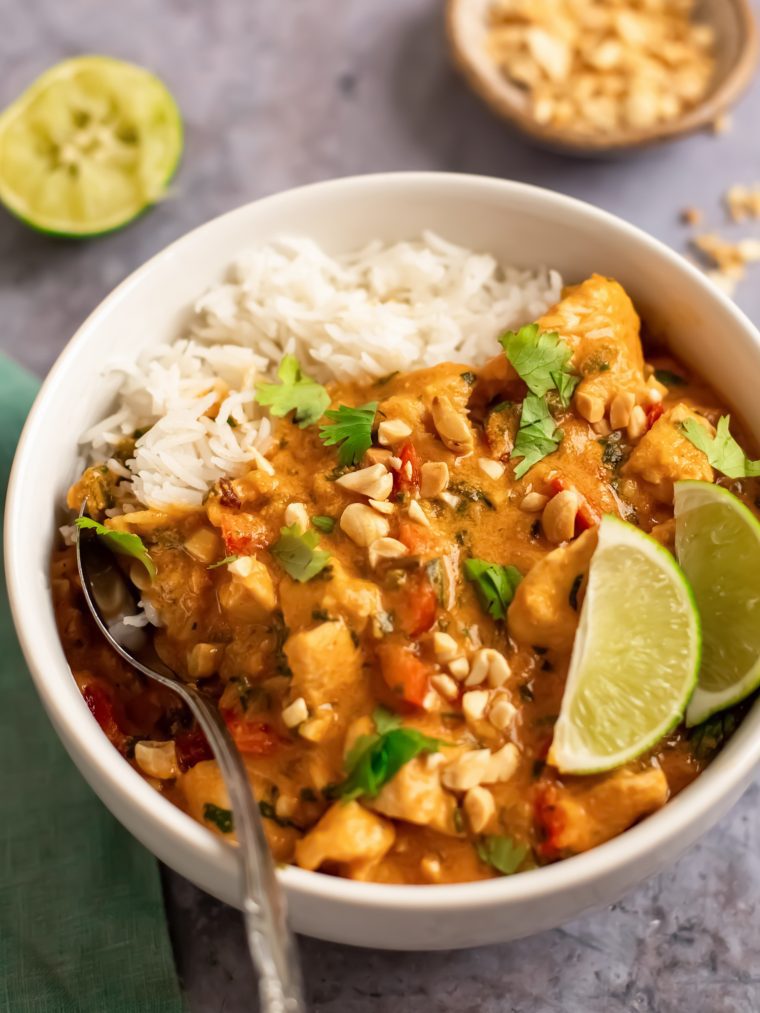
One of my go-to dishes when we go out for Thai food, Panang curry is a delicious variation of Thai red curry known for its subtle sweetness, mild spiciness, and the satisfying addition of peanuts. While authentic versions use homemade curry paste and a few items that can be hard to find in American supermarkets, my recipe is made with store-bought curry paste and other ingredients easily found in the Asian section of your local store. Taste-wise, it’s practically indistinguishable from traditional versions, and it comes together in just about 40 minutes. Pair it with jasmine rice and dinner is done!
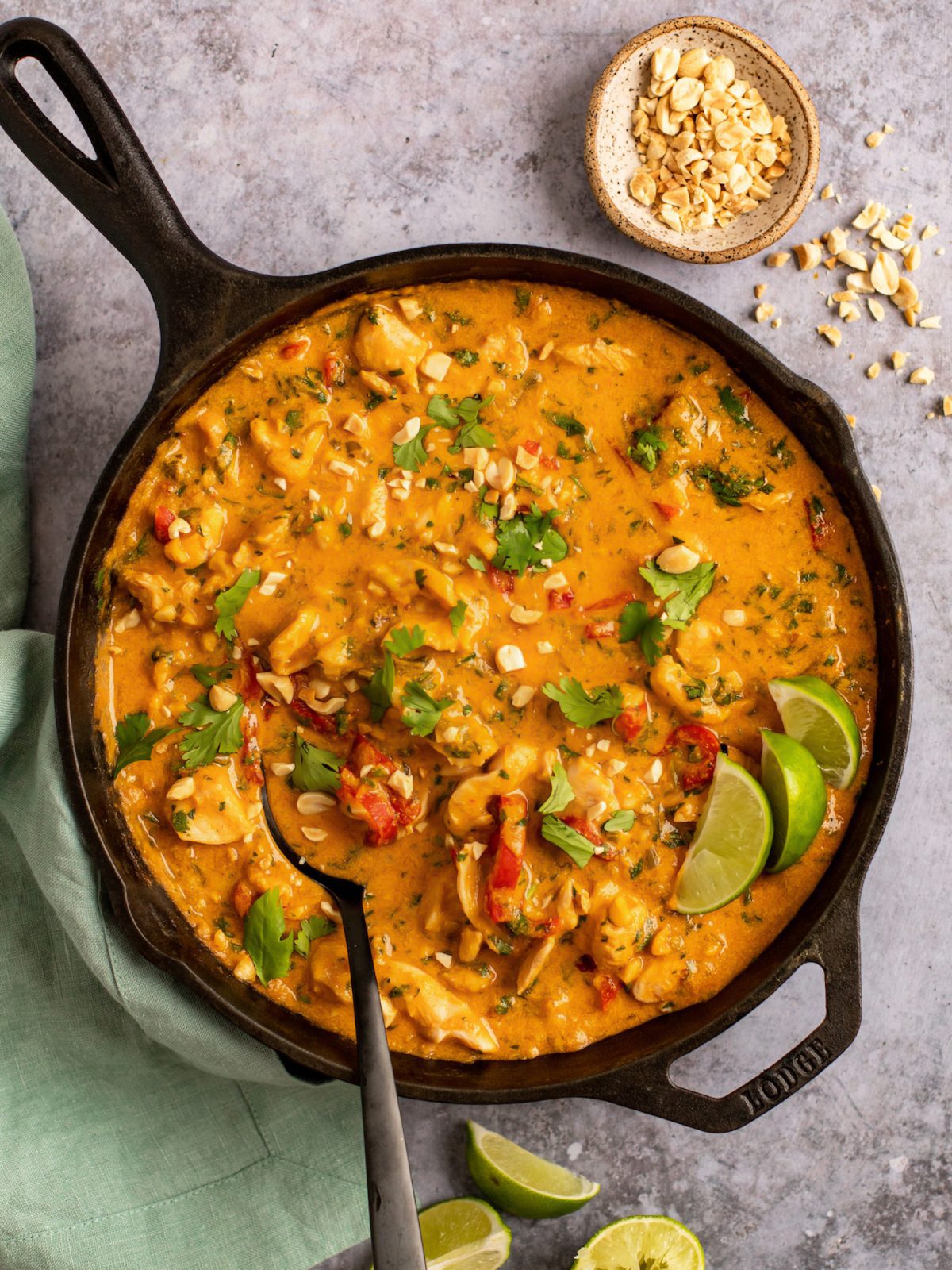
“So much flavour for so little effort. Your recipes never disappoint, but this one is a real winner.”
What You’ll Need To Make Panang Curry
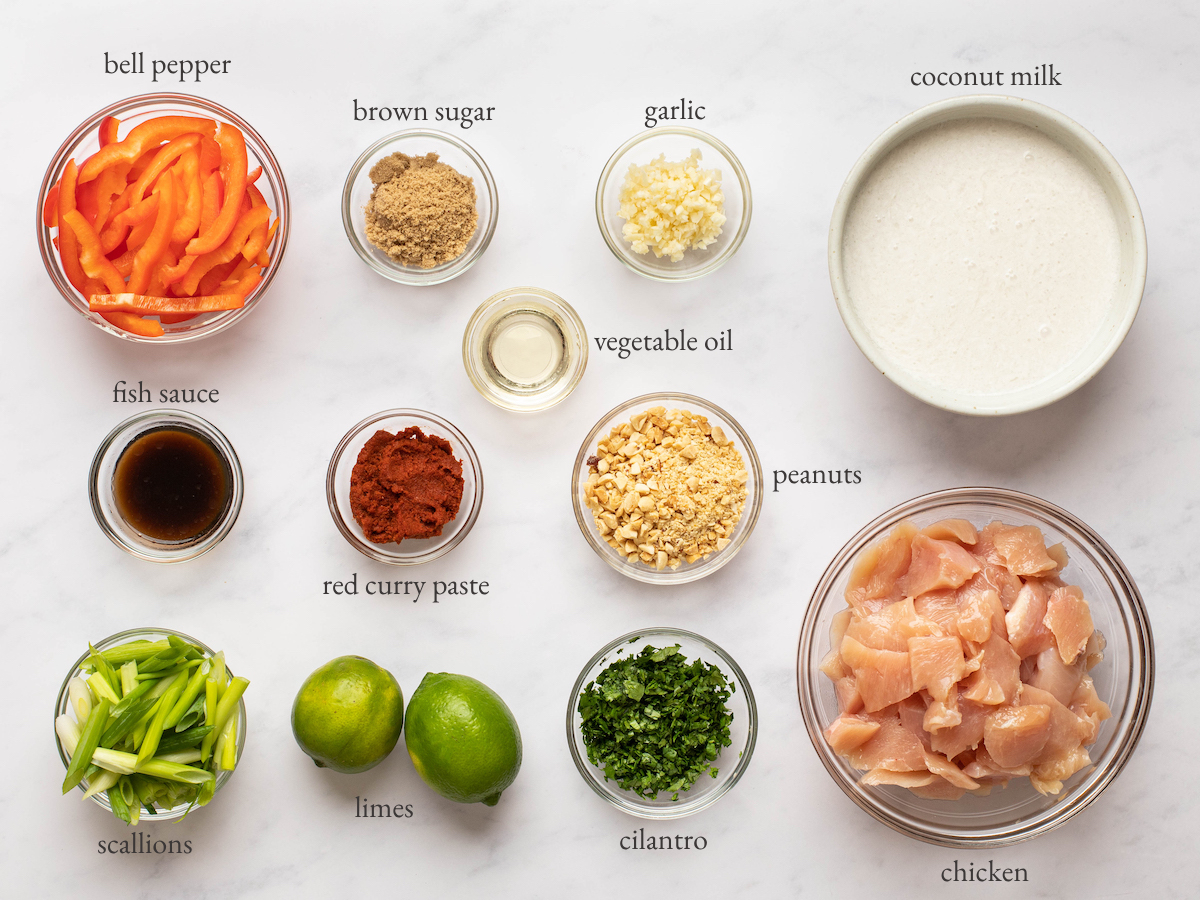
- Red Curry Paste: This flavorful paste combines lemongrass, galangal (a cousin of ginger found in Thailand), bright red chilis, and a medley of aromatic spices. Its heat level can vary significantly from one brand to another, so it’s always a good idea to taste-test and adjust accordingly. I use the Thai Kitchen brand.
- Coconut Milk: A staple in many curry dishes, it’s essential to opt for full-fat coconut milk to achieve that rich texture and taste. However, be aware that canned coconut milk’s consistency can differ depending on the brand. Some might be too watery, while others might separate in sauces. I’ve consistently had great results with the Thai Kitchen brand.
- Fish Sauce: A unique ingredient prominent in East Asian dishes, fish sauce is known for its robust salty and savory profile. It brings a depth of umami flavor to an array of recipes, from sauces and marinades to salad dressings. For the best flavor, look for brands imported from Thailand or Vietnam.
- Jump to the printable recipe for precise measurements
Step-By-Step Instructions
Heat the oil in a large nonstick pan over medium-low heat. Add the pepper and cook, stirring frequently, until softened and starting to brown, 3 to 4 minutes
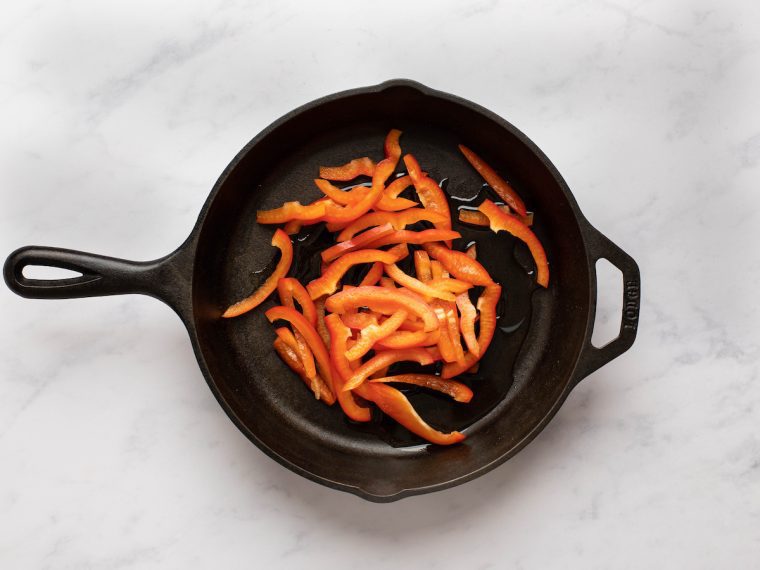
Add the scallions and cook, stirring frequently, until softened, 1 to 2 minutes.
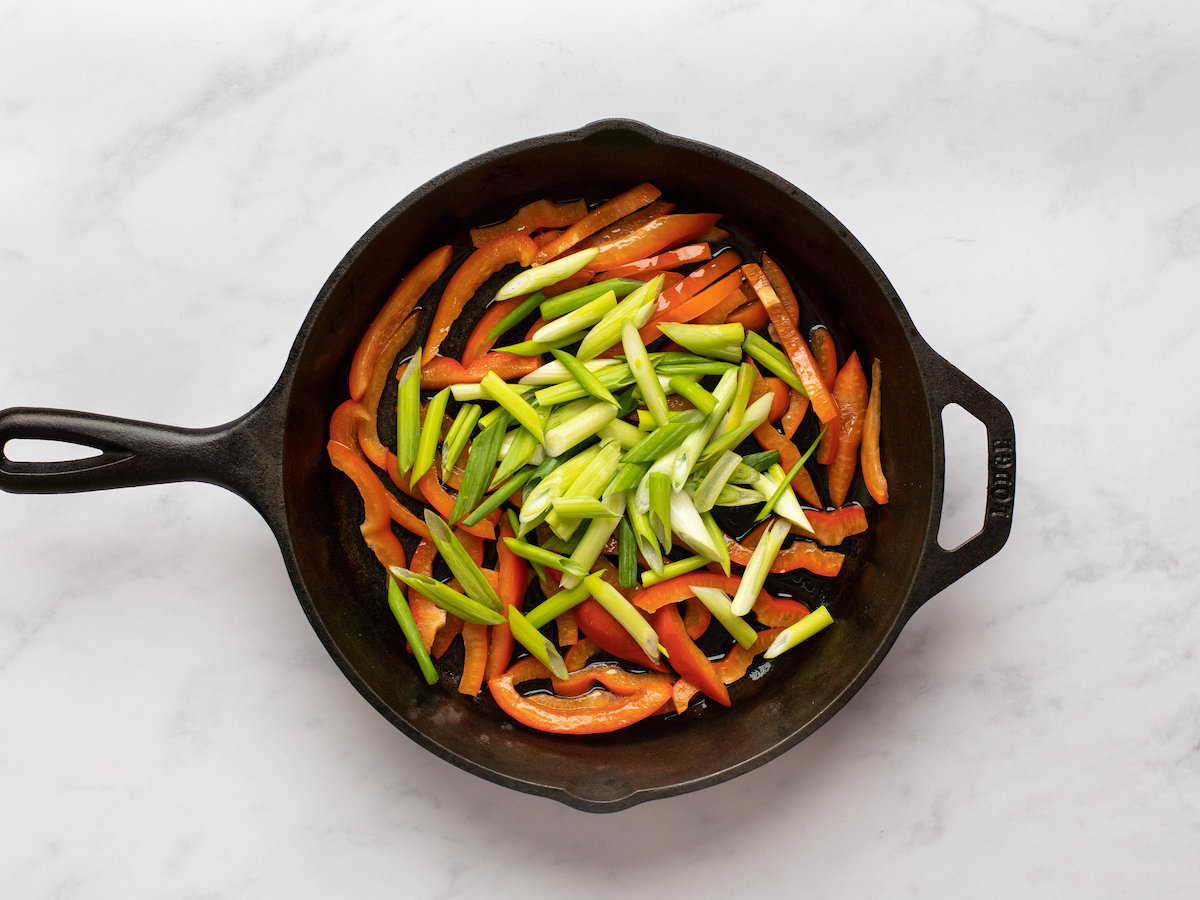
Mix in the garlic and cook, stirring constantly, for 30 seconds more; do not brown.
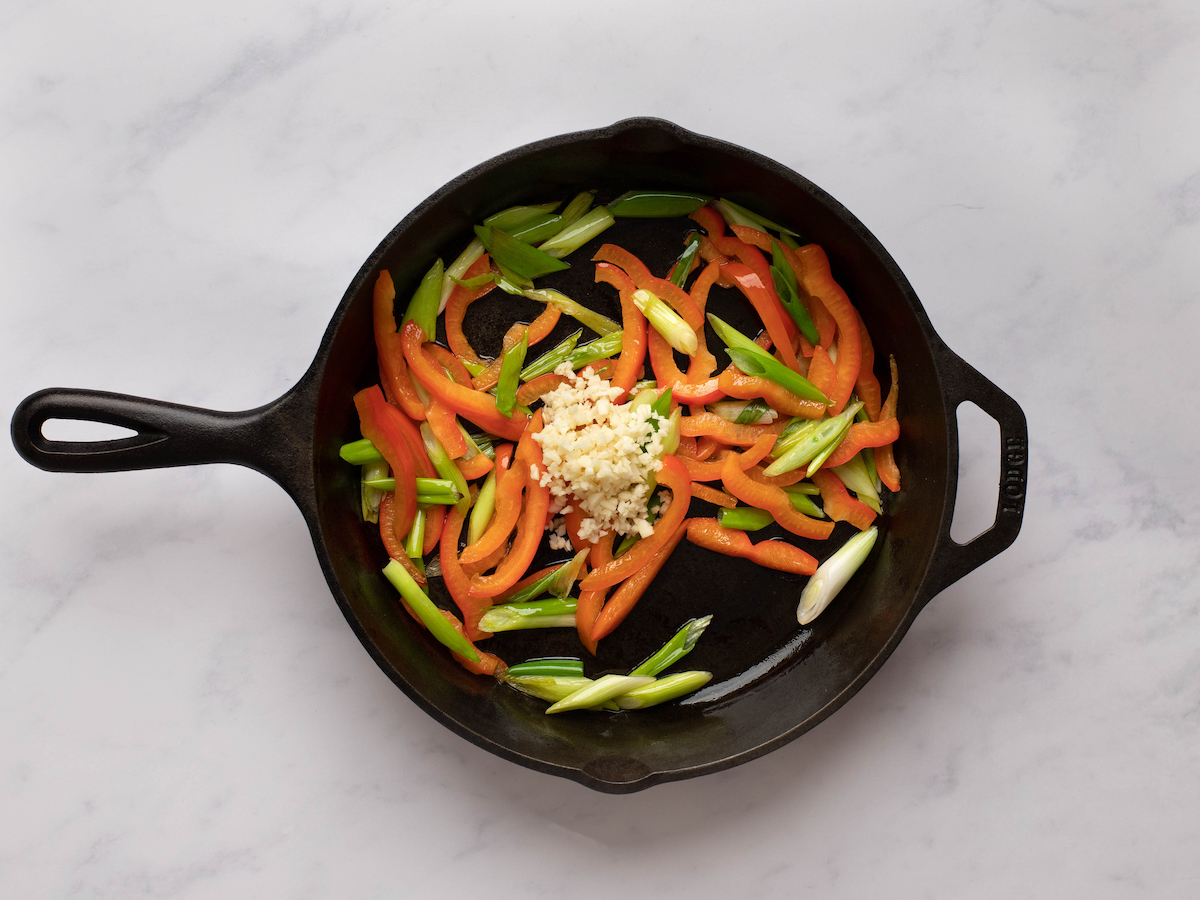
Add the coconut milk, curry paste, fish sauce, and sugar.
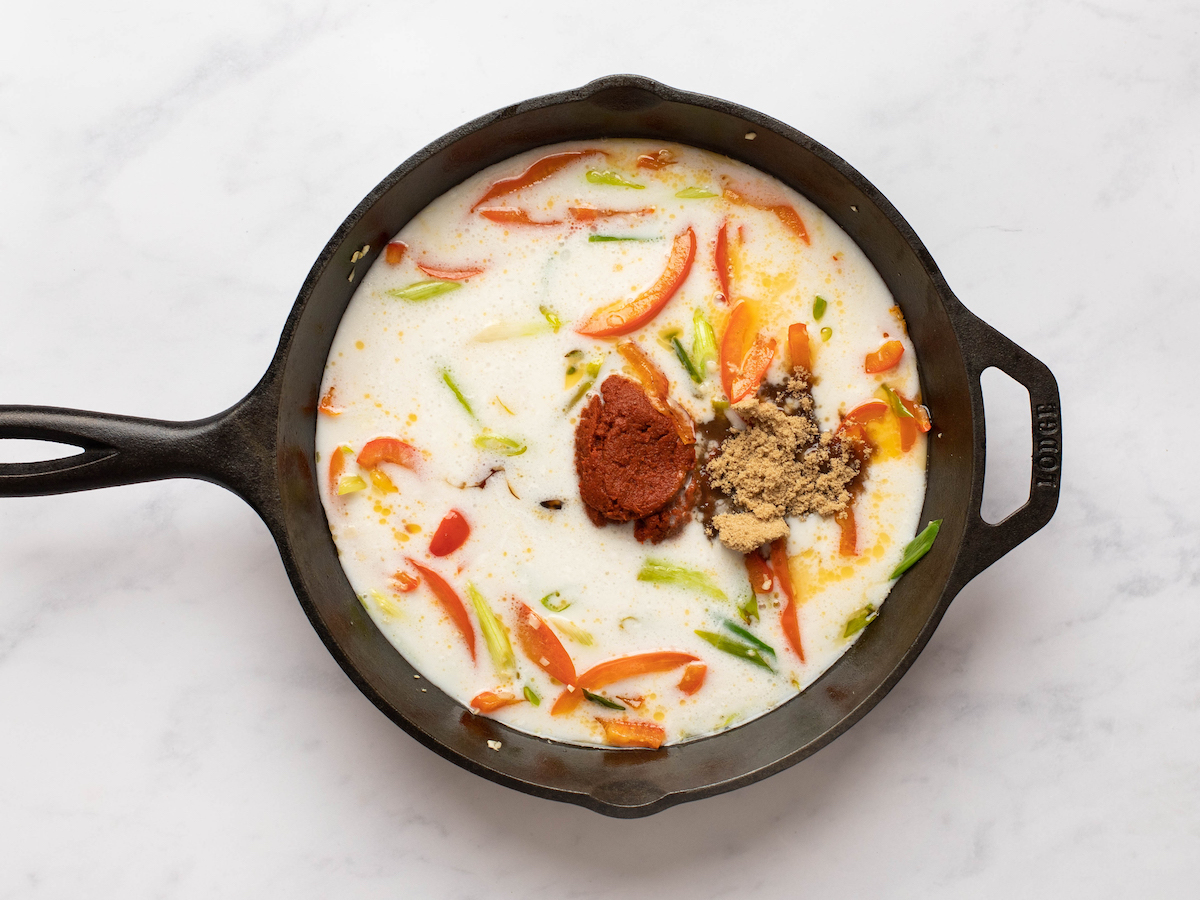
Whisk ingredients together.
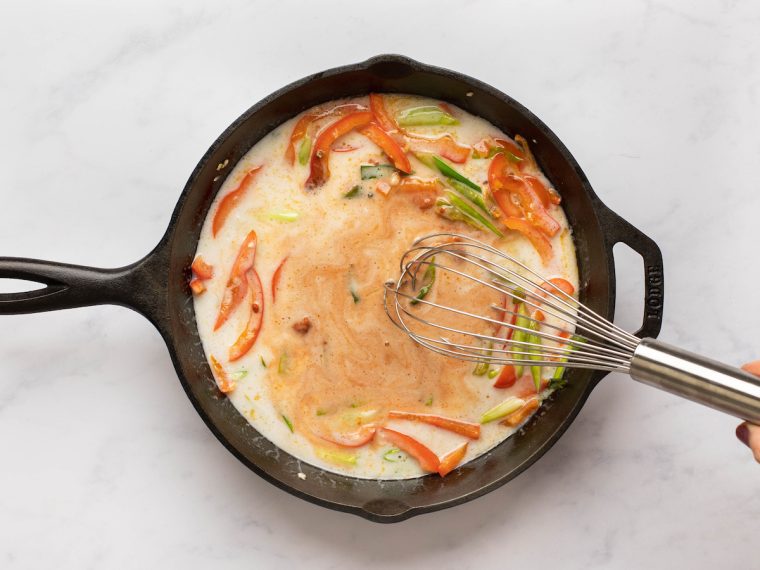
Bring to a gentle boil, then reduce the heat to a simmer and cook, uncovered, until slightly thickened, about 2 minutes. Add the chicken and simmer, uncovered, stirring occasionally to promote even cooking, until the chicken is cooked through, 5 to 8 minutes. (Do not let the sauce vigorously boil; the idea is to cook the chicken gently so that it’s tender.)
Mix in the lime juice, cilantro, and peanuts.
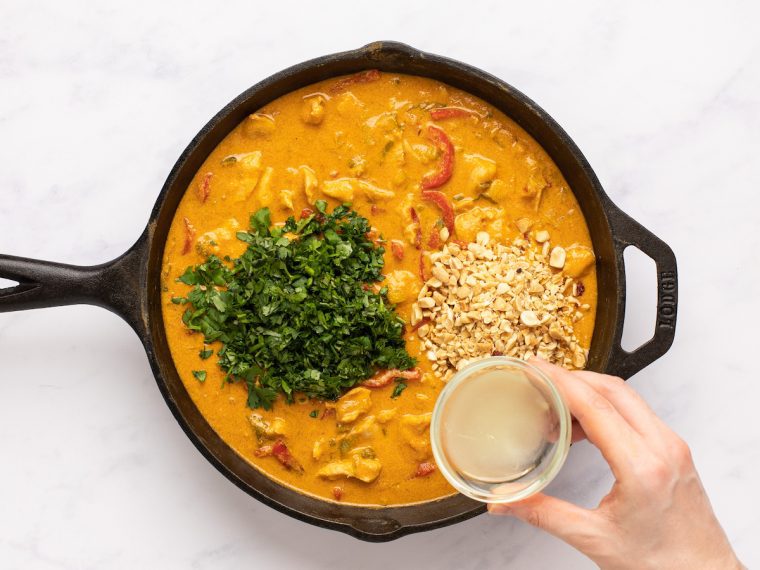
Stir gently to combine all ingredients.
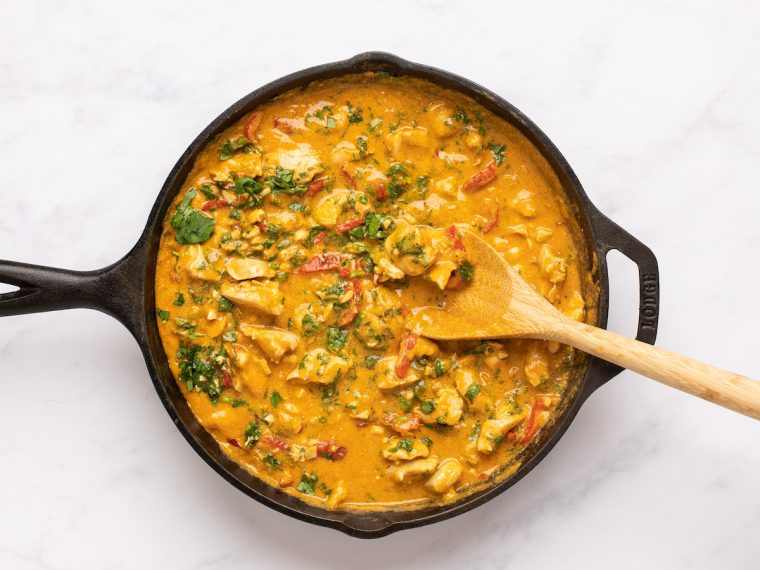
Taste and adjust seasoning with more lime, if necessary.
Frequently Asked Questions
Panang curry is known for its mild spiciness. However, the level of spiciness will vary depending on the brand of red curry paste you use; feel free to use more or less to adjust to your taste. I use the Thai Kitchen brand, which is mild.
Depending on the brand of coconut milk you use, it’s common for the sauce to separate in Panang curry during cooking. In fact, some Thai cooks prefer this separation as it can add depth to the dish. I use Thai Kitchen coconut milk, which does not tend to separate. However, if your sauce happens to separate, don’t worry about it—it will still be delicious.
Yes, you can absolutely make this ahead of time. After you’ve prepared your Panang curry, simply let it cool down to room temperature, then transfer it to an airtight container and store it in the refrigerator. When you’re ready to enjoy it, gently reheat the curry either on the stovetop or in the microwave until it’s heated through.
Nope! While many people might assume fish sauce imparts a fishy flavor, in reality, when used correctly, it adds depth and umami flavor without making the dish taste overtly like fish.
Video Tutorial
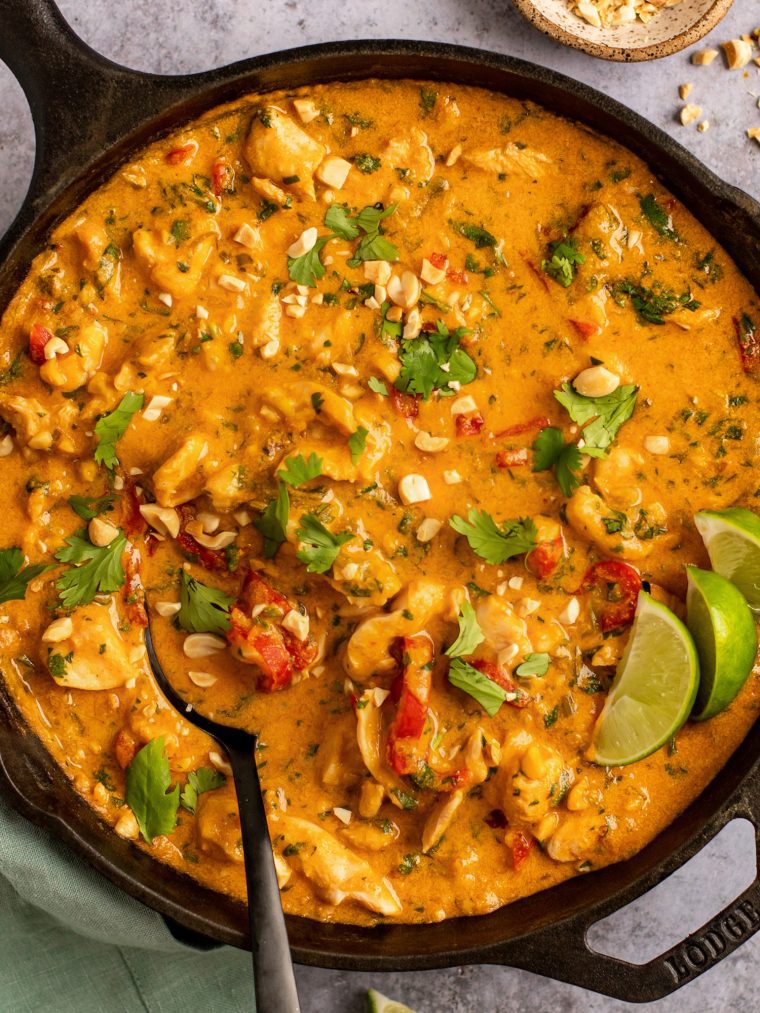
You May Also Like
Panang Curry
Recreate a Thai restaurant favorite at home! This easy Panang curry recipe combines tender chicken and vegetables in a fragrant coconut curry and peanut sauce.
Ingredients
- 1½ tablespoons vegetable oil
- 1 red, orange, or yellow bell pepper, diced
- 1 small bunch scallions, light and dark green parts, sliced diagonally into 1-inch pieces
- 3 cloves garlic, minced
- 1 (14-oz) can unsweetened coconut milk (see note)
- 2½ tablespoons Thai red curry paste
- 2 tablespoons fish sauce
- 2½ tablespoons packed dark brown sugar
- 1¼ pounds chicken breast or tenderloins, thinly sliced into bite-size pieces
- 1 tablespoon lime juice plus lime wedges for serving (you'll need 2 limes)
- ¼ cup fresh chopped cilantro
- ⅓ cup dry roasted peanuts, finely chopped
Instructions
- Heat the oil in a large nonstick pan over medium-low heat. Add the pepper and cook, stirring frequently, until softened and starting to brown, 3 to 4 minutes. Add the scallions and cook, stirring frequently, until softened, 1 to 2 minutes. Add the garlic and cook, stirring constantly, for 30 seconds more; do not brown.
- Add the coconut milk, curry paste, fish sauce, and sugar and whisk together. Bring to a gentle boil, then reduce the heat to a simmer and cook, uncovered, until slightly thickened, about 2 minutes. Add the chicken and simmer, uncovered, stirring occasionally to promote even cooking, until the chicken is cooked through, 5 to 8 minutes. (Do not let the sauce vigorously boil; the idea is to cook the chicken gently so that it's tender.) Stir in the lime juice, cilantro, and peanuts. Taste and adjust seasoning with more lime, if necessary. Serve with jasmine rice.
- Note: The consistency of canned coconut varies by brand. Some might be a bit watery, while others might separate in sauces. I've consistently had great results with the Thai Kitchen brand.
- Make-Ahead Instructions: Panang curry may be made ahead of time, but take care not to overcook the chicken. After you've prepared the dish, let it cool down to room temperature, then transfer it to an airtight container and store it in the refrigerator. When you're ready to enjoy it, gently reheat the curry either on the stovetop or in the microwave until it's heated through.
Pair with
Nutrition Information
Powered by ![]()
- Per serving (4 servings)
- Calories: 548
- Fat: 37 g
- Saturated fat: 21 g
- Carbohydrates: 20 g
- Sugar: 11 g
- Fiber: 3 g
- Protein: 39 g
- Sodium: 844 mg
- Cholesterol: 104 mg
This website is written and produced for informational purposes only. I am not a certified nutritionist and the nutritional data on this site has not been evaluated or approved by a nutritionist or the Food and Drug Administration. Nutritional information is offered as a courtesy and should not be construed as a guarantee. The data is calculated through an online nutritional calculator, Edamam.com. Although I do my best to provide accurate nutritional information, these figures should be considered estimates only. Varying factors such as product types or brands purchased, natural fluctuations in fresh produce, and the way ingredients are processed change the effective nutritional information in any given recipe. Furthermore, different online calculators provide different results depending on their own nutrition fact sources and algorithms. To obtain the most accurate nutritional information in a given recipe, you should calculate the nutritional information with the actual ingredients used in your recipe, using your preferred nutrition calculator.
Gluten-Free Adaptable Note
To the best of my knowledge, all of the ingredients used in this recipe are gluten-free or widely available in gluten-free versions. There is hidden gluten in many foods; if you're following a gluten-free diet or cooking for someone with gluten allergies, always read the labels of your ingredients to verify that they are gluten-free.

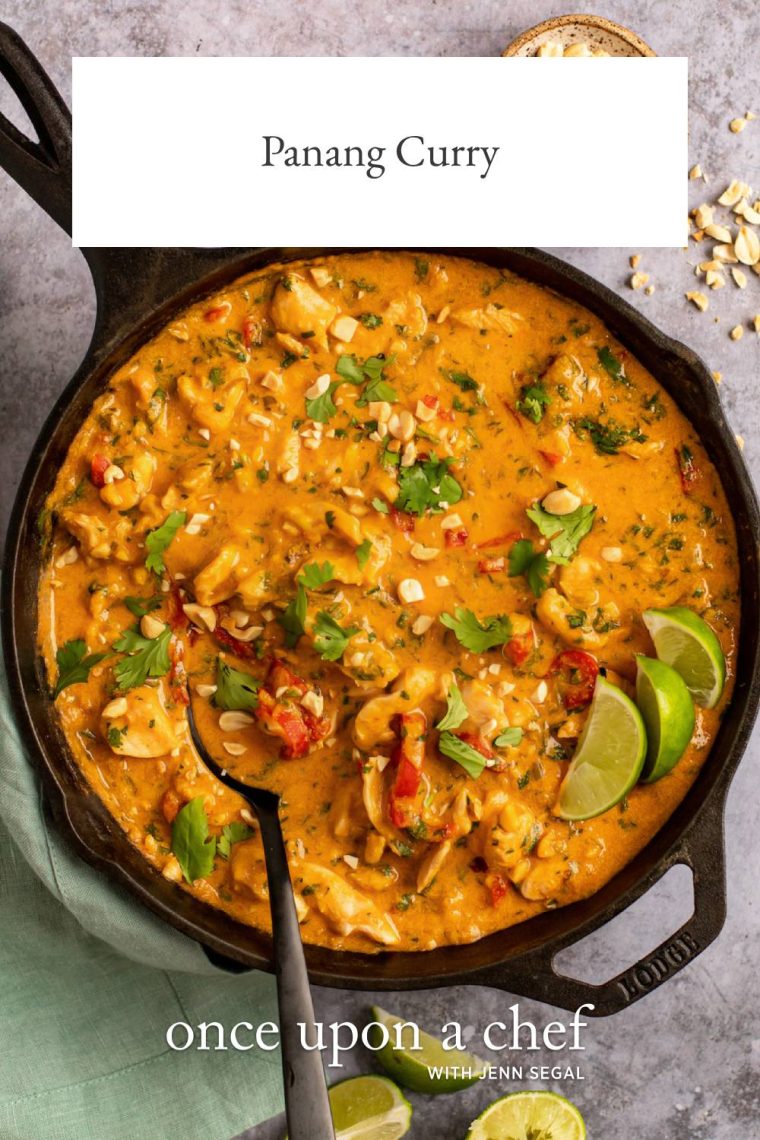
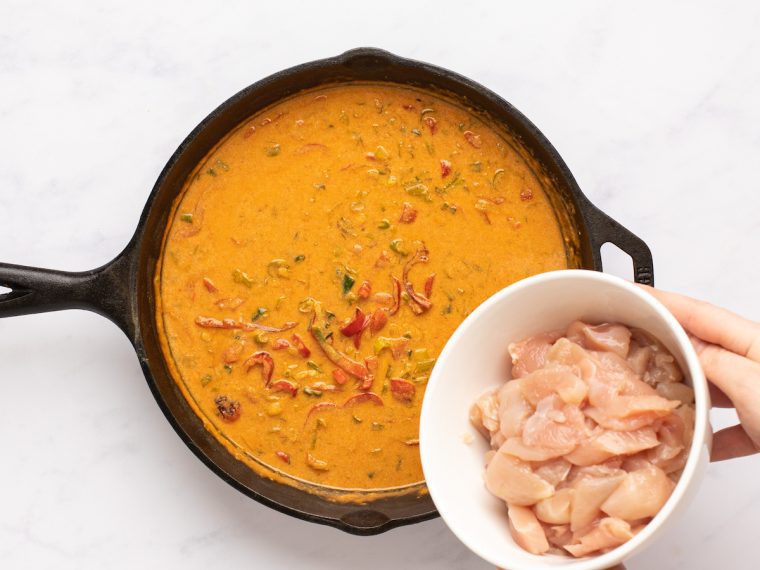

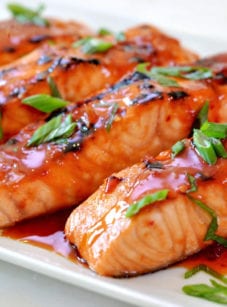
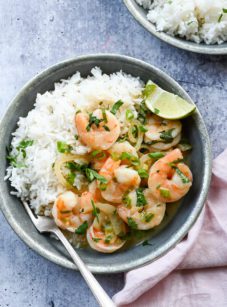
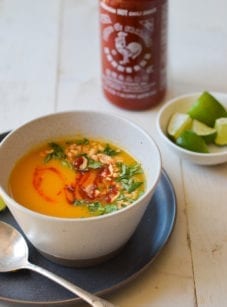
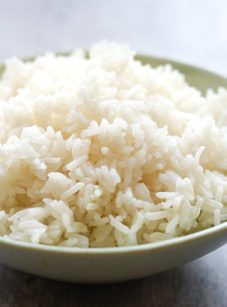
This was delicious!!! Will make for friends next time!! Yum!
I have finally found a great curry recipe! The entire family loved it. I have been struggling so thank you for sharing this. I am wondering if I could also make this with yellow curry so I have 2 recipes? Thank you
Yep!
Love your recipes! I would like to make this but we have recently switched to a vegan lifestyle and we don’t like tofu. Could we substitute roasted cauliflower for the chicken?
Sure, Anne – I think that would work well!
I don’t like “heat” but want good flavor. If I can get the type of curry paste you recommend, how much do you suggest I use? Should I do anything else to amp flavor while cutting back on curry paste?
Hi Nancy, The curry paste I use is not at all spicy so I don’t think you’ll need to cut back. Hope that helps!
would like to use shrimp. When do I add it?
Hi Carol, Depending on the size of the shrimp, it will only take 2 to 3 minutes to cook through, so I would add it at the end.
Vegetarian version– definitely use the Thai Kitchen brand red curry. Traditionally Panang Curry (“red curry”) is made with curry paste that contains shrimp paste. Thai Kitchen brand is the only red curry paste I know of that is vegetarian. Good to know for those with a shellfish allergy. I use soy sauce instead of fish sauce, and tofu instead of chicken. The “firm” tofu from Costco works well. Jenn, thank you for another excellent recipe!
So quick and easy to make and bursting full of flavor! Sweet from the brown sugar, tangy from the lime juice, vegetal from the red bell pepper, coconutty and red curry-tastic all at once 😀 Hubby and I immediately deemed this recipe “a keeper” and then he followed that up with “what other recipes does she have”? Thank you for keeping our tummies happy and full!
Delicious. Chicken was really tender. There was a lot of sauce so I added a can of chickpeas to ensure we had some leftovers for the next day. Would definitely make again.
Warming and comforting! I used Maesri kaeng pak curry paste purchased at a Thai market, providing a good punch of heat. I also loaded it up with frozen mixed veggies in addition to the chicken. I agree with other commenters and will likely use a little less fish sauce next time. But there definitely will be a next time. Thank you for another winning dinner!
Fantastic and nutritious meal! I substituted boneless, skinless chicken thighs because that’s what I had. I needed to sear and cook thighs prior to proceeding with rest of recipe to ensure thighs will cook completely. I also added sriracha sauce at the table for added heat. Thank you for another dinner winner!
Hello Jenn,
When I received the recent email that focused on this recipe, I went immediately to the store to shop for ingredients. I made it twice before the holidays, and last Monday, I thawed the last of the second attempt (turkey burnout). It was so so good. In both attempts, I used a slow cooker so that there was no hurry but allow the smells to linger. And in the second attempt, I found a coconut milk called Chaokoh in a local Indian store. It was a bit sweeter, but both versions were amazing: filled with rich peanutty taste finish. It was kind of “the more I ate, the more I wanted.”
I made this curry recipe a night ago in an attempt to cheer up a cold rainy evening. It went over so well that I now have standing orders from my family to always double the recipe. Thank you!